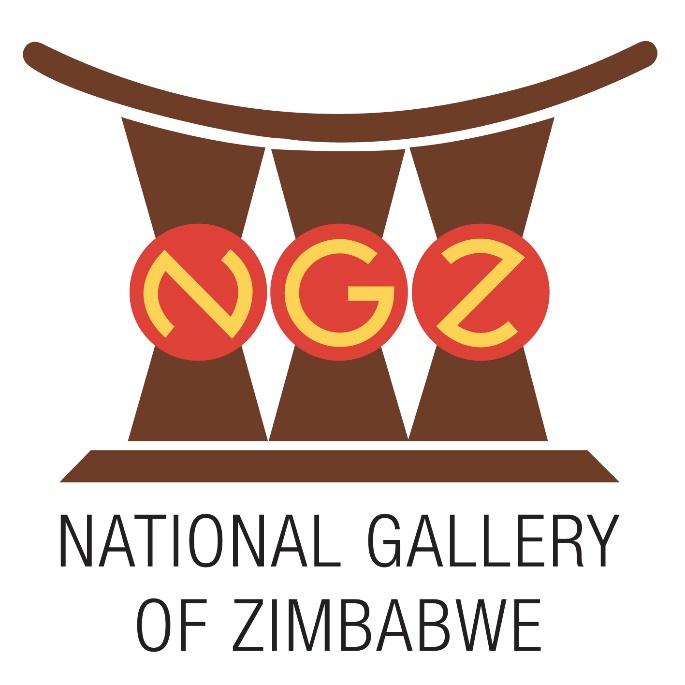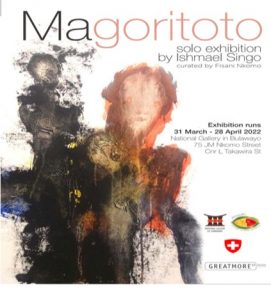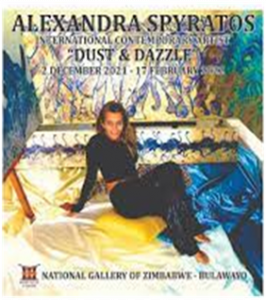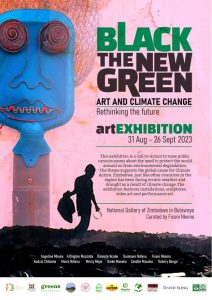
𝗧𝗵𝗲 Black the New Green 𝗘𝘅𝗵𝗶𝗯𝗶𝘁𝗶𝗼𝗻
This exhibition is a call-to-action to raise public consciousness about the need to protect the world around us from environmental degradation. The theme supports the global cause for climate action. Zimbabwe has been facing erratic weather and drought as a result of climatic change. The exhibition features installations, sculptures, video art and performance art.
Curated by Fisani Nkomo
Featured artists:
Fisani Nkomo Angeline Mhuka
Danisile Ncube Arlington Muzondo
Dumisani Ndlovu Kudzai Chikomo
Mavis Ndlovu Owen Maseko
Zandile Masuku Oubery Bango
Mercy Moyo

For our elders e𝘅𝗵𝗶𝗯𝗶𝘁𝗶𝗼𝗻
This exhibition was a dedication to the artists from Southern Zimbabwe, who had started practicing art before 1980. The project sought to shed light on on their lives and remarkable works which provided a unique insight into the social, political, and cultural influences that shaped their artistic expressions. Additionally accompanied by a documentary film, the showcase was sponsored and supported by the Australian Embassy as an exchange counterpart to NAIDOC.
Curated by Silenkosi Moyo
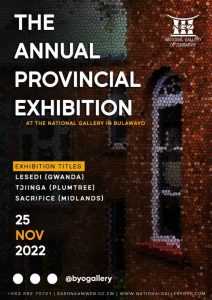
𝗧𝗵𝗲 𝗔𝗻𝗻𝘂𝗮𝗹 𝗣𝗿𝗼𝘃𝗶𝗻𝗰𝗶𝗮𝗹 𝗘𝘅𝗵𝗶𝗯𝗶𝘁𝗶𝗼𝗻
This was an exhibition of works from 3 groups of artists represented by the tripartite themes, Lesedi, Sacrifices and Tjinga. Firstly, Lesedi represented a group from Gwanda, having their theme interpreted as “Into the light”. This was viewed as a much needed commodity after being faced with disruptive waves of COVID 19 which had left artists negatively confined.
Secondly, Sacrifices represented a group from Midlands, showcasing various works that depict instances of unavoidable struggles community wide. Amoung different art forms and styles, a number of works typically coined women sacrificially working tirelessly to serve needs of their children.
Thirdly, Tjinga represented a group Plumtree, having the theme interpreted as “For so long”. The theme emphasises materialisation art that has existed solely within confines of studios and communities.
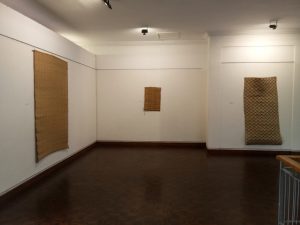
𝗧𝗵𝗲 Ethnographic 𝗘𝘅𝗵𝗶𝗯𝗶𝘁𝗶𝗼𝗻
This was an exhibition of ethnographic works from the gallery permanent collection. The showcase featured artifacts which represent the local cultural past, hence included blankets weaved from natural fibres, mats from reeds and woolen wall hangings.
These were selected from different regions, societies ethnic groups, all attesting to unique patterns, colour dyes and shapes
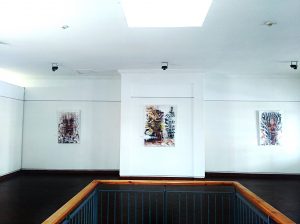
The Bold and Beautiful
African culture and tradition informs our way of life and despite the introduction of organised religion, totems are still widely used as a means of character identification through our African surnames.
This was the inspiration behind the Bold and Beautiful paintings which wereworked on and completed earlier this year. It’s a series of work referencing the spiritual narrative of our ancestors ; particularly those of women and animals Keith’s signature ‘footprints’ signify the history of our forefathers and ancestors who left their mark on this earth.
Philip Ian Butler July 2022
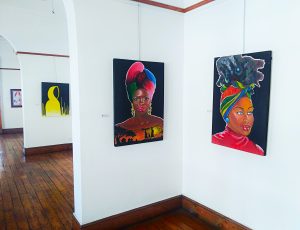
Imperceptible
This exhibition entitled ‘Imperceptible’ suggests slight differences. This is a collection of artworks created by gallery resident artists. This is a most interesting selection of art, which provokes considerable debate and discussion about life while at the same time celebrating the contrasting styles and techniques of art.
In this exhibition, artists have submitted art works that reflect and articulate the differences in styles, techniques and self-expression to motivate the sense of creativity.
Dumisani Ndlovu
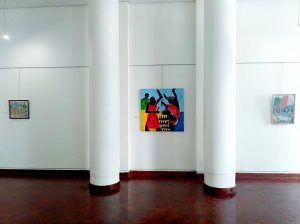 Roots
Roots
The theme incorporates artworks selected from the National Gallery’s permanent collection that are inspired by our cultural identity. Our culture, in this context, refers to the beliefs, norms, behaviours, and values that we live by. Therefore, artworks about cultural identity have been selected, and these explore both the intangible and tangible heritage as part of our culture. In this case, the exhibition aims to arouse the African enthusiasm in the audience, the feeling and sense of belonging as Africans.
Artworks such as, ‘my five wives’ represent a composition of women happily married to one husband, showing no sign of remorse. These are some of the traits we find to be customary within our culture. This promotes discourse whether to sympathize, question, or challenge some of these cultural practices in the contemporary era.
Chengetai Mkuka
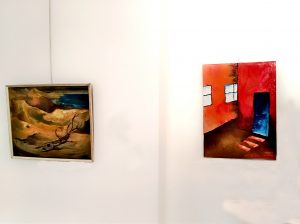 Transmuted Scapes
Transmuted Scapes
This exhibition marks the previous years’ COVID-19 peak that ravaged the landscapes. It was a time when people were confronted with numerous lockdowns and prolonged isolation in a bid to contain the virus that ravaged the land.
The exhibition Transmuted scapes features artworks from the permanent collection that appear to have been prophesied on the Covid 19 scenery. The painting, titled “Waiting Room” by Lamberth, shows people milling around in anticipation of the next move after the ‘wait’. The composition shows intense discussions, others throwing hands in the air as a sign of giving up, and others seeming unmoved by it all. Growing up in Zimbabwe’s city suburbs makes Dube’s composition a rare scene indeed; the emptiness of the streets is met with this unease.
Baron confirms the emptiness of the environment with the lone bench in a somber background of blues. Others turned to the spirit realm, as revealed in the painting by Bickle, giving hope to the hopeless. During the peak of Covid 19 no one dared touch plates or pots of the deceased, and we can sense this feeling from Reedo’s painting titled ‘for the birds’. These are reminiscing about situations that were met in homes and quarantine centres that transmuted once-populated places.
Doris T. Kamupira
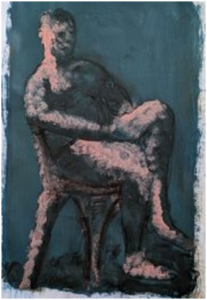
Live drawing
This is a collection of work from people who attended 5 weeks of classes at the NGZ BYO and generously funded by the Alliance Francais. Some were experienced resident artists, some who are studying to become art teachers from the Teacher Training College, but we also had a few who were completely new to the experience (the Author Bryony Rheam of “Under The September Sun” fame wrote a blog post about it). Using live models the work reflects a variety of styles and approaches showing a fine collection of both line and tonal work. Some are short poses of a few minutes whilst others are more studied compositions of nearly an hour.
Philip Ian Butler
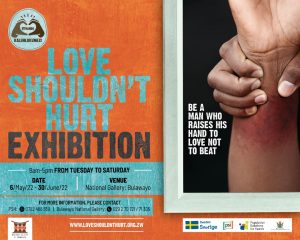
Love Shouldn’t Hurt
The Love Shouldn’t Hurt Exhibition sought to rally men to create dialogue to help perpetrators of violence adopt positive conflict resolution and anger management skills. The campaign helped towards reducing perpetration of violence manifesting through physical and sexual abuse. The exhibition also framed an understanding of that there are always alternatives to using violence.
RAISE YOUR HAND TO LOVE NOT TO BEAT!
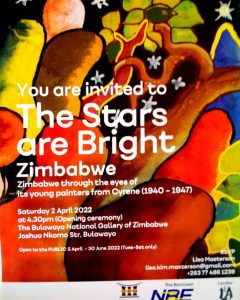
The Stars Are Bright
The exhibition took its tile from the artwork by Stanley Musa Nyahwa which originally toured England as part of the Cyrene exhibitions in the 1950s. Post the organisation of the exhibition, in late spring of 2020 and amidst the London pandemic, global changes preceded beyond anyone’s anticipation. The exhibition was presented in a way that was accessible and encouraging viewers to let their imagination take inspiration from the
environment in which the artworks were made. The baseline remained that there hasn’t been a single story of African Art and the Cyrene paintings reinforced this view. There is more research to be conducted into this body of work and the hundreds of artists who produced it, many of whom have been lost to history. It was always intended that the artworks would continue on to tour Zimbabwe, making what we hope will be fitting reunion with their natural setting.
Curated by
Chiedza Mhondoro, Jessica Ihejetah and Georgia Ward
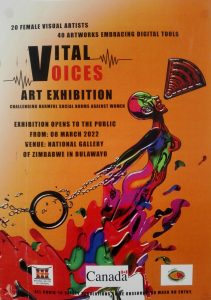
Vital Voices
Collaborative artistic women found solutions through work of art, by joining forces in different genres or mediums to fight gender-based violence, by relating in Animation, Graffiti/ mural, Video art, photography and Digital art. These female artists have found the legal way of expressing themselves on behalf of their fellow women. Graphic art, is traditionally a category of fine arts, including any form of visual artistic expression (e.g., painting, drawing, photography, printmaking), usually produced on flat surfaces.
With gender-based violence on the concentration, GBV is the most pervasive yet least visible human rights violation in the world. It includes physical, sexual, mental or economic harm inflicted on a person.
The series of workshops equipped 20 female artists with skills on how to embrace the power of digital media in the creation, distribution, and sale of their art. Digital spaces are a liberated field for creatives because they are free and fair to use for everyone without gender-based bias or discrimination. Through these workshops, the female participants were empowered to reclaim their voices by telling their own stories through art and sharing them with the world using the unlimited power of the digital world. Being part of this workshop entitled women to solve and find solutions to such.
Curated by
Danisile Ncube
Co- Curated by Mhle Nzima
Zandile Masuku
Magoritoto exhibition
The theme ”Magoritoto” is appropriated from the Shona vocabulary referring to ghosts (amathonga in isiNdebele), which are assumed to be entities seeking vengeance by tormenting the living.
The artist, Ishmael Singo embraces the cultural notion of hovering spirits through abstract figurative paintings. Ishmael’s work carries a bold accent of abstract form, mixed media, texture and shape to this body of works, he mostly employs muted colours and dark tones to represents the uncaring nature of Magoritoto.
The Exhibition challenges the viewers to interrogate, retrospect and reflect about their own ‘Goritotos’ they have to deal with in their own lives. The exhibition offers an opportunity to give the Goritotos’ a brave stare in a safe place
FISANI NKOMO
Dust and Dazzle exhibition
Translating the heat and the exotic beauty of the African wildlife to canvas became Spyratos’ passion and spiritual goal. Born in Kenya of Greek nationality, this prolific artist became known for her bold and individual style. Her paintings remain rich and textured with variegated copper leaf and pure gold, glitter and pure coloured silver, recreate the physicality of the wild that inspires her.
With forty-two solo shows behind her (Australia, USA, UK, Italy, China, South Africa, Uganda, Kenya, Portugal, Greece, Spain, Australia and Switzerland), Alexandra continues to expand her creative world, exploring and evolving in her in her contemporary style.
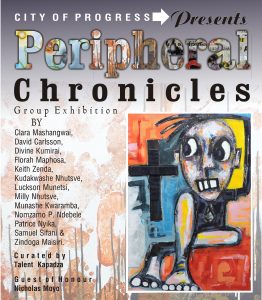
Peripheral Chronicles exhibition
Peripheral Chronicles mirrors self-worth and the artist chronicled his story a journey with albinism and all others like him hence visually expressed issues such as ‘Kuzvambaradza’ (Thoroughly beaten), ‘Competition for success’, ‘Recycling’ and ‘Nziranhete’ (The narrow road). In the periphery of Africa albinism chronicles cycles, disturbances, confusion and freedom. The artist depicted himself as a victim or still haunted by the past experiences in his painting portrayed a journey that is not certain; corrupted by prejudice and discrimination. There is always light at the end of the tunnel his hope is to stay and enjoy his freedom of being noticed, protected and recognised as a soul being regardless of colour or creed.
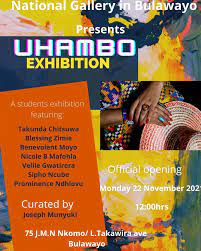
Uhambo Exhibition
Uhambo: a visual art exhibition, which brought to light matters about forced displacement of people, The artworks are from six young artists, who are students at Mzilikazi Art and Crafts Centre who have been on attachment at the National Gallery in Bulawayo since March 2021.
Displacement can be a result of persecution, conflict, generalized violence, or human rights violations. Not only is it a humanitarian concern, but it is also a developmental challenge.
Takunda Chitsuwa, Benevolent Moyo, Blessing Zimie, Prominence Ndhlovu, Sipho, and Velile Gwatirera created works of art that depict various forms of forced movement of people and their impact not only on the displaced but also on the host communities, bringing awareness to the world, about the suffering that people experience when they are forced to flee their homes.
The six young artists explore various themes through colour, texture, and ink. The exhibition advocates for change in the way human beings deal with displaced people under the unique characteristics of each situation. The pieces present the suffering and traumas which are permanently engraved in the hearts and minds of the affected.
Curated By Joseph Munyuki, National Gallery in Bulawayo
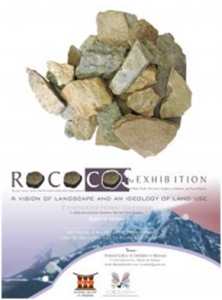
Rococo
Zimbabwe (Dzimbabwe) refers to the house of stones around Zimbabwe, the country with numerous rock sites, paintings and a few engravings. They reflect the rich spiritual and cultural heritage of humankind, yet having great significance to the futuristic descendants and contemporary societies.
There are locals particularly based on the hills and the consequently, the Matopos represents original nature inseparable from human culture. A humorous congruence of flora and fauna has founded the origination of naturalistic cultural assets and treasures. A relation between the natural world and the social world has then been evidenced by similarities amoung rock at depictions across Southern Africa.
